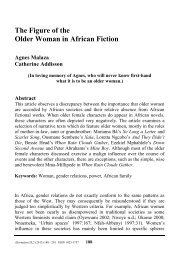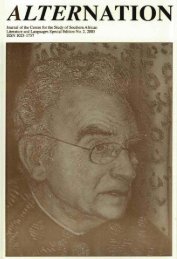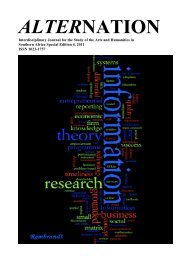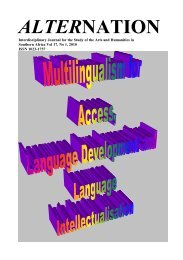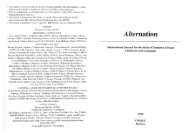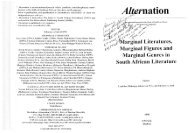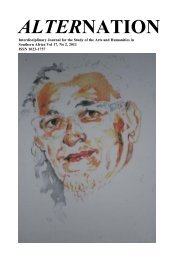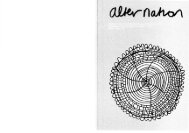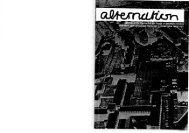Re-reading The Purloined Letter - Alternation Journal
Re-reading The Purloined Letter - Alternation Journal
Re-reading The Purloined Letter - Alternation Journal
You also want an ePaper? Increase the reach of your titles
YUMPU automatically turns print PDFs into web optimized ePapers that Google loves.
Pravina Pillay<br />
<strong>The</strong> letter then acts as the key decentring element in the text, in that it insists<br />
on being heard and affecting everyone in its proximity, even if they cannot<br />
decode its meaning into a consciously realized truth. In this sense it<br />
exemplifies what Lacan calls ‘the insistence of the signifying chain’, and<br />
chain of unconscious thoughts which Freud identified as the controlling<br />
psychological element.<br />
Another issue which runs through Lacan’s text is the question of the<br />
gaze, which is central to his theorization of the development of the subject<br />
and, in turn, crucial to the important work on subjectivity and the image<br />
which took its cue from Lacan. Since <strong>The</strong> <strong>Purloined</strong> <strong>Letter</strong> for Lacan hinges<br />
on a dynamic of mis-seeing; it also offers an allegory of how the gaze<br />
operates in psychic life. Lacan’s seminal essay of 1949 <strong>The</strong> Mirror Stage as<br />
Formative of the Function of the I, focuses upon the moment upon which the<br />
infant (aged between six and eighteen months) first identifies with a whole<br />
gestalt image of itself as separate from the world, a unity which is selfsufficient<br />
and contained. No longer, from this moment onwards,<br />
undifferentiated from the mother’s body or the sensual world around him,<br />
the child recognizes himself through identification of and with a selfimage—a<br />
reflection in the mirror, or through identification with another<br />
body like its own. This startling spectacle of the infant in front of the mirror<br />
is described by Lacan (1977:1f):<br />
Unable as yet to walk, or even to stand up, and held tightly as he is<br />
by some support, human or artificial … he nevertheless overcomes,<br />
in a flutter of jubilant activity, the obstructions of his support and,<br />
fixing his attitude in a slightly leaning-forward position, in order to<br />
hold it in his gaze, brings back an instantaneous aspect of the image.<br />
This is a transformative experience, signaling for the child entry into the<br />
Imaginary; the child imagines itself as whole through identification with the<br />
image it sees. Lacan (1977:1f) continues ‘we have only to understand the<br />
middle stage as an identification, namely, the transformation that takes place<br />
in the subject when he assumes an image’.<br />
<strong>The</strong> Imaginary is then opened up not only by the narcissism of the<br />
child at this moment before lack intrudes, but by an essentially visual<br />
experience—whether the child goes through this by actually looking in the<br />
382



